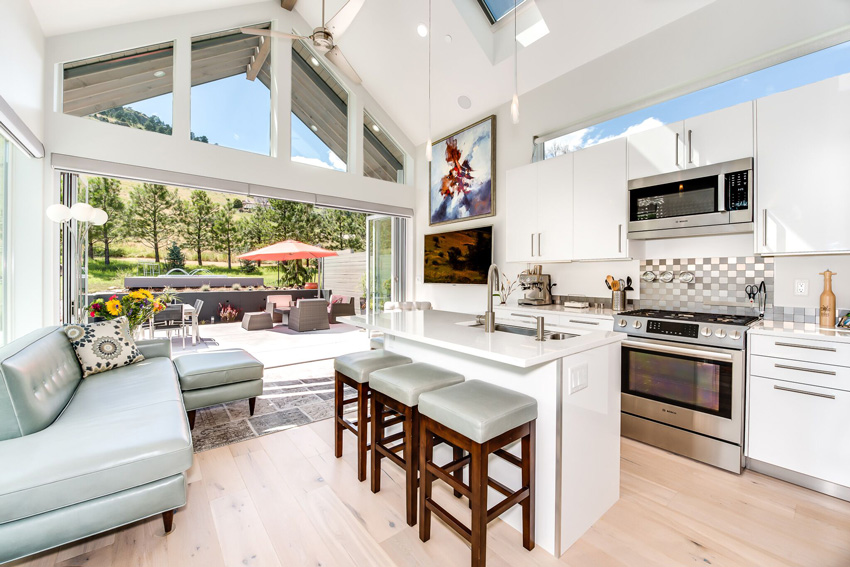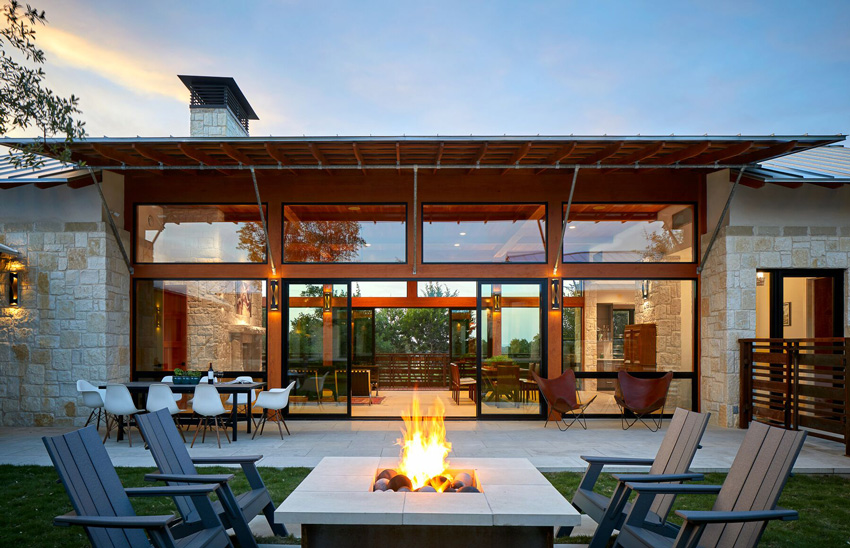Designing Beyond Borders
The Benefits of Bringing the Outdoors In
Multi-panel door systems not only open up design opportunities by removing the border between inside and outside, but they also enhance the sustainability of a structure. The components and operation of multi-panel systems have inherent environmental advantages.

Photo courtesy of Dan O’Connor
Project by Tomecek Studio Architecture
Multi-Panel Doors and Indoor Air Quality
A critical aspect of sustainable or green design takes into consideration indoor air quality (IAQ). Good indoor air quality means a healthier living environment. Indoor air quality refers to the air quality within and around buildings and structures, especially as it relates to the health and comfort of building occupants. Common pollutants can occur and build up indoors, creating the risk of indoor health concerns. According to the U.S. Environmental Protection Agency (EPA) and ASHRAE, in the past, residential ventilation was not a major concern because it was felt people were getting enough outdoor air by opening their windows and from air leaking through the building’s walls (infiltration). However, as homes and duct systems are built tighter to save energy and meet today’s codes, these tighter envelopes are more likely to trap contaminants indoors, raising concerns about indoor air quality. Studies from the Environmental Protection Agency on human exposure to air pollutants show that indoor levels of pollutants may be two to five times, and sometimes even more than 100 times, higher than outdoor levels. People in buildings frequently report discomfort and building-related health symptoms and occasionally develop building-related illnesses. Coupled with tighter homes, people now spend almost 90 percent of their day indoors—65 percent of that in their homes. Residents also are less likely to open windows because of energy costs, security issues, drafts, noise, and dirty air from outside, according to ASHRAE.
Indoor Air Pollution and Health
Understanding and controlling common pollutants indoors can help reduce the risk of indoor health concerns. The Environmental Protection Agency notes that health effects from indoor air pollutants may be experienced soon after exposure or, possibly, years later.
Immediate Effects: Various health effects may show up shortly after a single exposure or repeated exposures to a pollutant. These include irritation of the eyes, nose, and throat; headaches; dizziness; and fatigue. Symptoms of conditions like asthma may worsen. Such immediate effects are usually short-term and treatable.
The likelihood of immediate reactions to indoor air pollutants depends on several factors, including age and preexisting medical conditions. In some cases, whether or not a person reacts to a pollutant depends on individual sensitivity, which varies tremendously from person to person. Certain people can become sensitized to biological or chemical pollutants after repeated or high-level exposures.
Specific effects may be worsened by an inadequate supply of outdoor air coming indoors or from the heating, cooling, or humidity conditions prevalent indoors.
Long-Term Effects: Other health effects may show up either years after the exposure has occurred, or only after long or repeated periods of exposure. These effects, which include some respiratory diseases, heart disease, and cancers, according to the EPA, can be severely debilitating, or even fatal. For this reason, it is essential to try to improve the indoor air quality in homes even if symptoms are not noticeable.
There are three basic strategies for improving indoor air quality, as recommended by the Environmental Protection Agency: source control, improved ventilation, and air cleaners. Source control refers to improving indoor air quality through removing or eliminating individual sources of pollution, such as removing asbestos. Ventilation improvements refers to increasing the amount of outdoor air coming indoors. Air cleaners can be employed to remove pollutants and particles in indoor air.
Using Multi-Panel Systems to Help Achieve IAQ Goals
According to the EPA, lowering the concentrations of indoor air pollutants in a home means increasing the amount of outdoor air coming indoors. Mandatory standards, such as ASHRAE Standard 62.2, Ventilation and Acceptable Indoor Air Quality in Low-Rise Residential Buildings, and voluntary standards, like the Environmental Protection Agency’s Indoor airPLUS, provide guidelines on proper ventilation rates to secure indoor air quality.
The introduction of outdoor air is one important factor in promoting good air quality. Air may enter a home in several different ways, including: through natural ventilation, such as from windows and doors; through mechanical means, such as by means of outdoor air intakes associated with the heating, ventilation, and air conditioning (HVAC) system; and through infiltration, a process by which outdoor air flows into the house through openings, joints and cracks in walls, floors and ceilings, and around windows and doors. Using multi-panel systems opens up areas typically blocked by walls and aids in whole-house air circulation, bringing clean and fresh air into any structure and replacing existing, stale air. Larger openings allow for greater natural ventilation. By removing the divide between interior and exterior living spaces, multi-panel systems can also draw occupants outside more frequently.

Photo courtesy of Dror Baldinger Photography
Project by Craig McMahon Architects, Inc.
Additional Sustainability Benefits from Multi-Panel Door Systems
In addition to its vital role in improving indoor air quality, multi-panel door systems can further improve indoor health and energy efficiency in a building, both by their design and their components.
Natural Daylighting: Allowing for more glass and light, multi-panel door systems can be a good passive heat source and minimize the use of electricity for daytime lighting. Introducing daylighting into interior spaces is also beneficial for occupant health, reducing headaches induced by artificial light, and diminishing the symptoms of seasonally affective disorders.
As knowledge of the relationship between light and health increases, a better understanding of the circadian performance of the indoor environment can help to ensure that designers deliver projects that effectively support the biological lighting needs of building occupants, writes Kyle Konis, Ph.D., AIA, assistant professor of architecture at the University of Southern California (USC).
Providing daylight is important for the wellbeing of building occupants. How that daylight is provided inside of buildings is critical in the wake of emerging research showing the significant impact of light on the human circadian system. In modern buildings, Konis notes, light is often provided by electrical sources that may be adequate for the performance of visual tasks but lack the appropriate spectral composition and intensity required to stimulate the circadian system. Over time, lack of exposure to appropriate patterns of light/dark can disrupt the circadian system, leading to negative outcomes including poor sleep, reduced alertness, and increased risk for a range of health problems.
Under funding from the American Institute of Architects (AIA), Researchers at the University of Southern California are working on a metric and software workflow to help architects maximize the circadian-effective area of a project using daylight during design. Unlike the daylight metrics used in green building rating systems, which evaluate the amount of light delivered to a horizontal workplane over the year, a circadian daylight metric must assess light exposure at the eye and must also be sensitive to the timing, intensity, duration, wavelength, and past history of light exposures.
The area-based circadian daylight metric can be used to understand “when” and “where” interior daylight is effective for circadian stimulus. In the early stages of design, the goal is to maximize the area achieving the highest entrainment quality grades by adjusting the building form, massing, aperture size, and ceiling height while balancing additional concerns such as functional efficiency, program requirements, and cost. In later stages of design, the metric can be used to inform the selection of building components, such as glazing and facade systems, and controls for automated shading systems. By allowing replacement of an entire wall with glass, multi-panel systems can maximize provision of beneficial light to the interior.
Energy Efficiency: Most multi-panel door systems offer dual-paned tempered glass, creating an insulating barrier between the inside and out. Manufacturers may offer advanced low-e glass options to help reduce cooling costs in the summer and heating costs in the winter. Overall U-factors (insulating factors) in the door panels can be achieved at or near the common fenestration target of 0.30 or better, depending on specific glazing selections made for low-e or other coatings.
Maximum Use: The innovative design of multi-panel systems connects both indoors and out, maximizing a space’s livability and connecting occupants to the exterior of a structure.
Local Manufacturing: Finding a domestic or local manufacturer contributes to green design by minimizing fuel and transportation costs normally associated by importing products from areas outside of the United States.
Recycled Packaging and Materials: Certain manufacturers pack and ship systems using recycled materials, providing safe transport and smart use of renewable resources.
Responsible Materials: If wood or clad multi-panel door systems are under consideration, certain manufacturers offer FSC-certified wood. The Forest Stewardship Council (FSC) sets forth principles, criteria, and standards to guide forest management and practices toward sustainable forestry worldwide. FSC certifiers verify that companies claiming to sell FSC-certified products have tracked their supply back to FSC-certified sources. This chain of custody certification assures that consumers can trust the FSC label.
LEED Projects: Multi-panel door systems can help to earn a LEED designation for projects. Architects and project owners can submit many of these characteristics for point consideration within their projects.
Possible LEED v3.0 Points Opportunities:
- Energy & Atmosphere Prerequisite 2
- Energy & Atmosphere Credit 1
- Materials & Resources credit 2
- Indoor Environment Quality Credit 4.4
- Indoor Environment Quality 6.2
- Indoor Environment Quality 8.1
- Indoor Environment Quality 8.2
Measuring the Green Performance of Doors and Windows in Your Structure
Under an all-encompassing evaluation by The National Fenestration Rating Council (NFRC), a multi-panel door system earns credit for all of its energy-efficient features, including energy efficient glass, thermally improved frames, and even down to such minutiae as the spacers used between layers of insulated glass.
NFRC testing also looks at other overall performance characteristics, including the solar heat gain coefficient (SHGC), which measures how much solar energy passes through a particular glazing, creating heat gains within a building. SHGC is expressed as a number between 0 and 1. In areas where heat gains are a concern, coatings are applied to the glass to allow less transference. “NFRC: 100 Procedures for Determining Fenestration Product U-factors” is the accepted standard for rating windows, doors, and skylights for U-factor. A U-factor is typically rated between 0.20 and 1.20. This standard establishes standardized environmental conditions, product sizes, and testing requirements so that architects and others can make informed choices fairly and accurately by comparing the performance of different products.
NFRC testing also responds to green building standards by assigning a value to the visible light transmittance (VT). Values are between 0 and 1. VT determines the effective light available for daylighting, helping gauge potential offset of electricity costs for lighting a building’s interiors.
In addition to thermal performance, codes and standards—including those of the NFRC—have increasingly recognized air leakage (AL) as a very significant factor in fenestration performance. Today’s window and door products must meet minimum standards for air infiltration and be tested, certified, and labeled for this performance. The total system must be able to withstand wind pressures associated with its geographic location, and air leakage must be controlled not only for energy performance but also for occupant comfort and long-term durability of the fenestration system. NFRC expresses AL as a number ranging between 0.1 and 0.3.
U-factor, SHGC, VT, and AL are all disclosed on an NFRC label for an individual product. The lower the U-factor, the better the insulation level of the unit, meaning less loss of heat to the outside. A low SHGC means more solar energy will be blocked, eliminating passive heat gain into the building from outside. The higher the VT, the more natural light is transmitted through a product. A higher AL means greater air infiltration over the life of the product.
Typical high-performance doors have lower U-factors and SHG depending on climate zone. The most suitable AL rating for an energy-efficient building will be at or near 0.1; VT is dependent upon climate zone and client preference.









